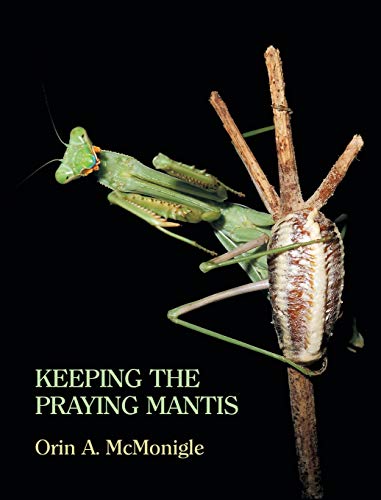Spiny flower mantis is one of the most stunning flower mantises, along with the orchid mantis and devil’s flower mantis. Like the two other flower mantises, the spiny flower mantis is not easy to care for. Here’s the full spiny flower mantis care guide that will help you.
To keep spiny flower mantis, place it in a small, escape-proof and ventilated container filled with twigs. Males can be housed together, but females must be housed separately. Mist twice a day to keep the mantis hydrated. Keep the mantis between 26-30 °C (79-86 °F), and offer it flying insects for food.
While those steps look simple, there are more things that you need to know, so that your spiny flower mantis can successfully reach adulthood, and even breed. Continue reading if you want to learn more.
Introduction to Spiny Flower Mantis
Both Pseudocreobotra wahlbergii and Pseudocreobotra ocellata are collectively known as the spiny flower mantis. Originated from Africa, the presence of spine-like structures on their body has earned them their name. In general, P. wahlbergii is larger, has more spines, and brighter in color than P. ocellata.
On top of that, adult spiny flower mantis has unique markings on its body, including one that looks like an eye on each forewing. The eye-like markings also resemble a “9”. Hence, they are also called the number 9.
When threatened, spiny flower mantises raise their forelegs and wings. It makes them look larger, at the same time revealing the eye markings to startle their enemy. This is known as the deimatic display.
When hunting, they pretend to be a flower to lure unsuspecting prey. Once the prey gets near enough, the mantis quickly snatch the prey with its strong raptorial forelegs.
The adult spiny flower mantis can grow up to 4 cm in length. The average lifespan of adults is 6-9 months, with females having a longer lifespan.
Why is Spiny Flower Mantis Hard to Care for?
Spiny flower mantises are considered hard to care for, because younger nymphs are extremely susceptible to dehydration, but yet can’t tolerate high humidity. Moreover, they eat mainly flies, which are more difficult to manage compared with crickets or roaches.
Having said that, they are not as difficult as the orchid mantis and devil’s flower mantis. Some people would still recommend spiny flower mantis for beginners. If you are looking for something even easier, choose those commonly kept mantis for beginners.
Enclosure for Spiny Flower Mantis
The spiny flower mantis can be housed in a small or medium size enclosure. Make sure the height of the container is at least 3 times the length of your mantis to facilitate molting. The length and width of the container should be around 2-3 times the length of your mantis, so that it has some space to move around.
Do not put your mantis in a container too big for it to find its prey. Younger nymphs (first/second instar) can be temporarily housed in a small deli container, and moved to a bigger container as they grow.
Bedding can be as simple as a paper towel. This will facilitate cleaning, since you just need to replace the paper towel as it gets dirty.
Decorate the enclosure with a lot of twigs for your mantis to climb on. Spiny flower mantis prefers to stay on the twigs than on the floor.
Make sure the enclosure has a lot of vents for ventilation. Spiny flower mantises don’t do well without ventilation. Moreover, good ventilation can prevent molds.
Whenever possible, choose a housing with a mesh cover, not only for the sake of ventilation, but also to allow the mantises to molt by hanging themselves on the mesh. There is more vertical space for molting by hanging on the mesh cover than hanging on a twig in the enclosure.
Can Spiny Flower Mantises be Housed Together?
Spiny flower mantises can be housed together during the first, second and third instar stages. Give them sufficient food to avoid cannibalism. Separate and house older females individually, because they are more aggressive. Males can continue to be kept together. A 30 x 30 x 50 cm enclosure can fit 5 adult males.
Quenching the Thirst – Water
Spiny flower mantises, especially the nymphs, are extremely susceptible to dehydration. You can provide them water by misting the enclosure with clean water. Do that twice a day: once in the morning and once at night. The mantis will take a sip from the water droplets.
Do not mist directly onto the nymphs. Spiny flower mantis likes to keep itself dry.
Consider adding some mosses into the enclosure. The mosses can retain water, and provide additional moisture to your mantis.
Make sure the enclosure is well ventilated. Otherwise, the nymphs will die from excessive moisture and molds.
Temperature
Keep the spiny flower mantis between 26-30 °C (79-86 °F) during the day. Temperature at night can be lower, but should not be less than 20 °C or 68°F.
You can use either a heat mat or heat lamp to keep the temperature warm.
If you plan to use a heat mat, get one with a thermostat for better temperature control. Place the heat mat at one side of the enclosure to create a heat gradient, so that the mantis can move to where it feels comfortable.
If you plan to use a heat lamp, avoid LED lamps, since they produce insufficient heat. Play around with the lamp wattage and distance to get the desired temperature.
How to Feed the Spiny Flower Mantis
Spiny flower mantises prefer to feed on flying insects. Depending on the size of your mantis, feed them fruit flies, house flies or blow flies. You should feed the mantis once its stomach becomes flat.
Flightless fruit fly is an excellent choice for the younger nymphs. As your mantis turns larger, you can swap over to house flies and blow flies. They are convenient to use. You can leave the fly pupae on a dry plate in the mantis enclosure if you need to be away for a few days.
You can refer to my guide on choices of feeder insects and how to cultivate them for your mantis.
If your mantis struggles to hunt, you can hand-feed it. Simply hold the feeder insect using a tweezer or needle, and offer it to the mantis. The feeder insect can be offered alive or dead (freshly killed). You can also offer a portion of the feeder insect (eg. leg only) if your mantis is too small.
Remember, you should always give small prey to your mantis, especially if they are young nymphs. That will increase the success rate of hunting. When the mantis reaches adulthood, the prey can be as big as the mantis.
Sometimes, your mantis may refuse to eat. Check out the reasons and how to deal with it in this article.
Recommended Supplies
Here’re my recommended supplies and resources that you can consider getting for your mantis. I’ll earn a small commission from eligible purchases you make after clicking those links. It helps me maintain this site without additional cost to you.

Keeping the Praying Mantis
This is great book by Orin McMonigle on mantis keeping. Written in an easy to understand and concise manner, this is the ultimate guide that any serious mantis-keepers need to read!
- Enclosure
- Lighting
- Thermometer/Hygrometer
- Heat mat
- Tweezers
- Fly pupa
- Fruit flies
- Small crickets
- Dubai cockroach
- Mealworms
Molting Care
Spiny flower mantis undergoes incomplete metamorphosis to reach adulthood. It takes 6-8 molts before they become adults. Each instar has different coloration depending on the environment.
When the spiny flower mantis is about to molt, it becomes inactive and looks fatter than usual. It will also stop feeding.
Make sure there are places for the mantis to hang itself upside down, either on the mesh enclosure cover or twigs. The space below the hanging point should be at least twice the length of your mantis. Keep the mantis hydrated by misting the enclosure to increase the chances of successful molting.
How to Breed Spiny Flower Mantis?
The breeding advice for spiny flower mantis is generally the same as what I’ve outlined in the mantis breeding guide, which you should refer to. While it is not easy to breed, spiny flower mantis is also not the hardest.
To breed spiny flower mantis, place the mature male and female in the same enclosure, and let them mate. Remove the male after mating. The gravid females lay an egg sac within 1 to 2 weeks. The eggs will hatch between 1-2 months if kept between 26-30 °C (79-86 °F) at 50-60% humidity.
The female spiny flower mantis is rather aggressive. It’s always a good idea to feed her a few hours before introducing the male mantis, so that she doesn’t see the male as food.
If the male mantis doesn’t attempt to mount on the female, remove him. Try again the next day. The male should be at least 1 week old, while the female should be at least 3-4 weeks old before you attempt to breed them.
Since the male mantis grows slightly faster than the female, you can slow down the growth rate by keeping it under cooler temperature. Conversely, you can accelerate the growth of the female by raising the rearing temperature.
How to Sex Spiny Flower Mantis?
Female spiny flower mantis have thinner antennae, longer wings and exposed abdominal side lobes. Meanwhile, males have thicker antennae but shorter wings that cover the side lobes. The female is bigger and bulkier than the male, and has 6 abdominal segments instead of 8.
Bear in mind that those characteristics are visible only after the 3rd or 4th instar. They become more apparent with each molt. Wings are present only in adults.


